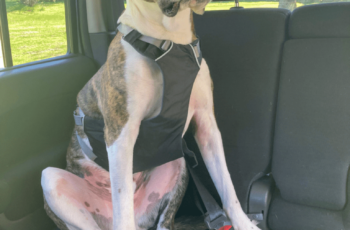
For over a decade, the scientific behavior community has been telling us that trying to be the human “alpha” is a seriously flawed approach to changing your dog’s behavior. Despite this, there is still a plethora of information online and in books that purport to teach you how to be an alpha to your dog.
Reading through some of that advice in preparation for writing this article, I feel physically chilled. I can’t imagine living in a home where I had to “demand respect” and “assert my dominance in everything I do” around my dog, to “make him get out of my way” if he’s lying in my path, or other equally absurd recommendations. And I don’t think I’m alone; I don’t know many dog owners who want to live in some sort of canine detention center, where the dogs must be reminded at every turn that I’m the boss!
I’m not going to go on and on; I just want to give some encouragement to anyone who has fallen prey to this sort of indoctrination. If you have been intimidated by an instructor into yanking on your dog’s leash, or told that your “softness” is the reason your dog is misbehaving, know this: These are outdated methods that are no longer recommended by today’s behavior experts.
WE CAN ALL JUST GET ALONG
Today’s humane, successful, and enjoyable approach utilizes methods that create a relationship with your dog based on mutual trust, love, and respect. Real leadership looks like:
- Showing and teaching. Use lure-shaping to teach your dog to lie down on cue, rather than pushing on her shoulders or pulling down on her collar. Or “capture” the down by “marking” it with the click of a clicker or a verbal marker, such as the word “Yes!” and giving her a treat whenever she lies down on her own, until she understands this is a great way to win more rewards and starts offering the “down” more frequently. Then just add your cue! (See “The Allure of the Lure,” WDJ July 2018, and “How to Get a Dog to Behave,” August 2014.)
- Understanding. Recognize that when your dog doesn’t do something you ask her to do, it’s because something is interfering with her ability to do so – she may be stressed, distracted, in pain, or simply hasn’t learned the behavior as well as you thought.
- Empathizing. Comfort your dog when she is stressed, hurting, or confused instead of insisting that she perform.
- Forgiving. If your dog did something that upset you, whether she soiled your carpet or snapped at you when you picked up a shoe she had snagged, don’t hold it against her. Our dogs are doing their best to make sense of a human world that often makes no sense to them. They are, however, really good at reading our body language, and if you stay angry about something your dog has done she’ll know you’re upset with her (and be stressed about it), but she won’t know why.
Do your dog a life-enhancing favor and eschew the use of force and intimidation in favor of cooperation and trust. In the end, your role as a benevolent leader rather than an alpha dictator will make life better for both of you.
Author Pat Miller, CBCC-KA, CPDT‑KA, is WDJ’s Training Editor and author of many books on dog-friendly dog training. See “Resources,” page 24, for book and contact information.


